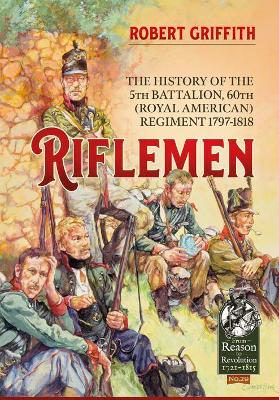Reason to Revolution
2 total works
The 5th Battalion of the 60th (Royal American) Regiment was the first rifle battalion in the regular British Army. Raised in 1797, it marked a significant step in the development of British light infantry and rifle corps. Lieutenant Colonel Francis de Rottenburg, the battalion's commander for almost 10 years, formulated the first British Army light infantry manual.
After serving in Ireland during the 1798 rebellion, in the West Indies, and in the Americas, the battalion rose to fame during the Peninsular War. It was one of only three battalions to be present from the initial landings in Portugal through to the invasion of France, and victory six years later. Divided between the brigades of Wellington's army to provide specialist rifle and skirmishing capability, the riflemen often formed advance or rear guards, patrols and outposts. Frequently praised by Wellington and his divisional commanders, the battalion won 16 battle honours.
Drawing on official records, memoirs, court martial transcripts, inspection reports, and unpublished letters, Riflemen recounts not only the campaigns in which the battalion fought, but also many personal stories of the soldiers who served with it. Riflemen includes tales of murder, promotion from the ranks, desertion, prisoners of war, and small actions that are often overlooked. As the first history of the battalion written in almost 100 years, it sheds new light on a vital component of Wellington's army and its important place in the history of the British Army.
After serving in Ireland during the 1798 rebellion, in the West Indies, and in the Americas, the battalion rose to fame during the Peninsular War. It was one of only three battalions to be present from the initial landings in Portugal through to the invasion of France, and victory six years later. Divided between the brigades of Wellington's army to provide specialist rifle and skirmishing capability, the riflemen often formed advance or rear guards, patrols and outposts. Frequently praised by Wellington and his divisional commanders, the battalion won 16 battle honours.
Drawing on official records, memoirs, court martial transcripts, inspection reports, and unpublished letters, Riflemen recounts not only the campaigns in which the battalion fought, but also many personal stories of the soldiers who served with it. Riflemen includes tales of murder, promotion from the ranks, desertion, prisoners of war, and small actions that are often overlooked. As the first history of the battalion written in almost 100 years, it sheds new light on a vital component of Wellington's army and its important place in the history of the British Army.
Rowland Hill was one of the Duke of Wellington's most trusted subordinates, known for caring deeply for the welfare of his men, but the battles of Arroyomolinos (1811) and Almaraz (1812) show that he was far more than just 'Daddy Hill' and a safe pair of hands. He was also a general of considerable skill and daring. At Arroyomolinos he led his troops for days through appalling weather to out-manoeuvre and then decimate an entire French division in a perfectly conceived surprise attack. At Almaraz he advanced far from allied lines to capture and then destroy a vital French bridge, overcoming considerable logistical challenges and substantial defences, and paving the way for Wellington's victory at Salamanca.
For both actions Hill used the same two British infantry brigades, as well as Portuguese and Spanish units. The relatively small numbers of units involved has enabled the author to give greater focus on the individual regiments and the men who served in them than is often the case with larger battles. He uses memoirs, previously unpublished letters, and official returns and reports to paint a very detailed picture of two small but important battles of the Peninsular War and the men that fought them.
For both actions Hill used the same two British infantry brigades, as well as Portuguese and Spanish units. The relatively small numbers of units involved has enabled the author to give greater focus on the individual regiments and the men who served in them than is often the case with larger battles. He uses memoirs, previously unpublished letters, and official returns and reports to paint a very detailed picture of two small but important battles of the Peninsular War and the men that fought them.

